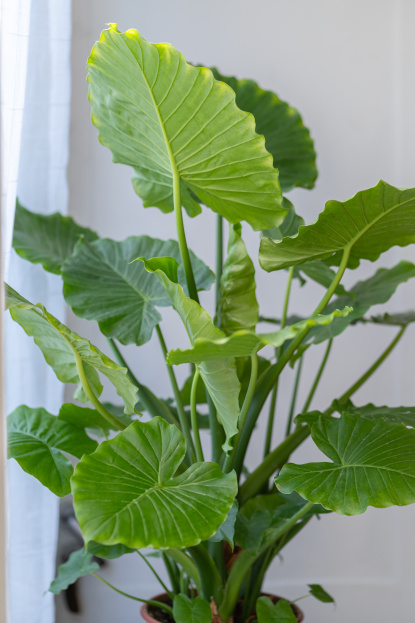
With its towering, tropical presence and massive, upright leaves, Alocasia portadora—often called Elephant Ear—is a true statement plant. Whether you’re creating a jungle-inspired corner or adding height to your plant collection, this striking hybrid brings a bold, sculptural look indoors or out.
Alocasia portadora thrives in bright, indirect light. Place it near a window with filtered sun or use a sheer curtain to protect it from intense afternoon rays, which can scorch the leaves. It can tolerate a bit of direct morning sun, but low light will slow its growth and result in smaller leaves.
Keep the soil consistently moist but not soggy. Water when the top inch of soil feels dry, and make sure your pot has proper drainage. Overwatering can quickly lead to root rot, while underwatering may cause drooping or browning leaf edges. Adjust watering frequency with the seasons—less in winter, more during active growth in spring and summer.
Use a well-draining, chunky soil mix—ideally something designed for aroids. You can mix potting soil with perlite, orchid bark, and a bit of peat or coco coir to help with aeration and moisture control. Repot every 1–2 years or when roots begin circling the bottom of the pot.
Alocasia portadora prefers warm temperatures between 65–85°F (18–29°C). Avoid cold drafts, sudden temperature drops, or exposure to temperatures below 60°F (15°C), which can stress the plant and lead to dormancy.
This tropical beauty loves high humidity. Aim for at least 60% humidity indoors. Use a humidifier, place a pebble tray under the pot, or group it with other plants to help increase moisture in the air. Dry air can lead to crispy leaf edges.
Propagation is best done through rhizome division. When repotting, you may find new offsets or “pups” around the base. Gently separate these and pot them in fresh soil. Alocasias don’t propagate well from cuttings, so division is the most reliable method.
Unfortunately, Alocasia portadora is not pet safe. It contains calcium oxalate crystals, which are toxic to cats, dogs, and humans if ingested. Keep it out of reach of curious pets and children.
Feed your plant every 4–6 weeks during the growing season (spring through early fall) with a balanced, water-soluble fertilizer diluted to half strength. Avoid over-fertilizing, as this can cause salt buildup in the soil and damage the roots.
Likely due to overwatering or poor drainage. Check your soil moisture and pot drainage.
Yes—Alocasias often go into a semi-dormant phase during colder months. Water less frequently and wait for new growth in spring.